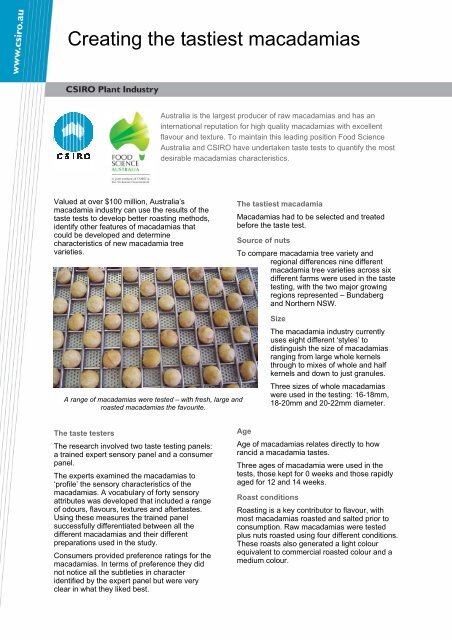MacaTasteTest_PI_pdf - CSIRO
MacaTasteTest_PI_pdf - CSIRO
MacaTasteTest_PI_pdf - CSIRO
Create successful ePaper yourself
Turn your PDF publications into a flip-book with our unique Google optimized e-Paper software.
Creating the tastiest macadamias<br />
Australia is the largest producer of raw macadamias and has an<br />
international reputation for high quality macadamias with excellent<br />
flavour and texture. To maintain this leading position Food Science<br />
Australia and <strong>CSIRO</strong> have undertaken taste tests to quantify the most<br />
desirable macadamias characteristics.<br />
Valued at over $100 million, Australia’s<br />
macadamia industry can use the results of the<br />
taste tests to develop better roasting methods,<br />
identify other features of macadamias that<br />
could be developed and determine<br />
characteristics of new macadamia tree<br />
varieties.<br />
The tastiest macadamia<br />
Macadamias had to be selected and treated<br />
before the taste test.<br />
Source of nuts<br />
To compare macadamia tree variety and<br />
regional differences nine different<br />
macadamia tree varieties across six<br />
different farms were used in the taste<br />
testing, with the two major growing<br />
regions represented – Bundaberg<br />
and Northern NSW.<br />
A range of macadamias were tested – with fresh, large and<br />
roasted macadamias the favourite.<br />
Size<br />
The macadamia industry currently<br />
uses eight different ‘styles’ to<br />
distinguish the size of macadamias<br />
ranging from large whole kernels<br />
through to mixes of whole and half<br />
kernels and down to just granules.<br />
Three sizes of whole macadamias<br />
were used in the testing: 16-18mm,<br />
18-20mm and 20-22mm diameter.<br />
The taste testers<br />
The research involved two taste testing panels:<br />
a trained expert sensory panel and a consumer<br />
panel.<br />
The experts examined the macadamias to<br />
‘profile’ the sensory characteristics of the<br />
macadamias. A vocabulary of forty sensory<br />
attributes was developed that included a range<br />
of odours, flavours, textures and aftertastes.<br />
Using these measures the trained panel<br />
successfully differentiated between all the<br />
different macadamias and their different<br />
preparations used in the study.<br />
Consumers provided preference ratings for the<br />
macadamias. In terms of preference they did<br />
not notice all the subtleties in character<br />
identified by the expert panel but were very<br />
clear in what they liked best.<br />
Age<br />
Age of macadamias relates directly to how<br />
rancid a macadamia tastes.<br />
Three ages of macadamia were used in the<br />
tests, those kept for 0 weeks and those rapidly<br />
aged for 12 and 14 weeks.<br />
Roast conditions<br />
Roasting is a key contributor to flavour, with<br />
most macadamias roasted and salted prior to<br />
consumption. Raw macadamias were tested<br />
plus nuts roasted using four different conditions.<br />
These roasts also generated a light colour<br />
equivalent to commercial roasted colour and a<br />
medium colour.
And the winner is…<br />
The most popular macadamias identified by the<br />
consumers were fresh (kept for 0 weeks before<br />
consumption), large (18-22mm in diameter),<br />
roasted and slightly darker than an average<br />
retail macadamia.<br />
The good news for growers is that consumers<br />
did not identify any taste difference between<br />
nuts sourced from different macadamia tree<br />
varieties, or macadamias on different farms or<br />
regions.<br />
The trained panel was, however, able to relate<br />
the features the consumers preferred to the<br />
various treatments and sources of nuts. This<br />
information allows growers and producers of<br />
macadamias to get a clearer picture of<br />
consumer likes and dislikes.<br />
Freshness<br />
Consumers easily detected rancid macadamias<br />
even though their rancidity level was within<br />
industry standards. Industry could use this<br />
information to improve rancidity tests to ensure<br />
a more consistent supply of fresh macadamias<br />
to consumers.<br />
Overall, however, the consumers noted that<br />
even the most aged macadamias presented to<br />
them for testing were better than some nuts<br />
they had purchased from retail sources. This<br />
suggests that current shelf stock could also be<br />
improved.<br />
Roasting<br />
Roasting at either 135oC for 18 minutes or<br />
155oC for 8 minutes recorded the same taste<br />
results. Industry could adopt the shorter roast<br />
time to increase production efficiency without<br />
compromising flavour.<br />
Other factors for industry<br />
Consumers were also asked why they chose<br />
macadamias in relation to their mood, health,<br />
convenience, sensory quality and price. The<br />
results suggested that sensory quality and price<br />
are foremost in people’s minds when buying<br />
macadamias.<br />
There is potential to expand the domestic<br />
macadamia market through education and<br />
consumer exposure to a broader spectrum of<br />
macadamia sensory experiences given the<br />
expert panel identified a diversity of macadamia<br />
flavours.<br />
Opportunities to expand the macadamia market<br />
may also exist in the health market, especially if<br />
concerns about fat content raised by female<br />
consumers are addressed and the health<br />
benefits are publicised.<br />
Drawing on <strong>CSIRO</strong>’s expertise in plant and<br />
human nutrition science, efficient experimental<br />
design and statistical analysis, this project has<br />
delivered a practical outcome for the<br />
macadamia industry.<br />
<strong>CSIRO</strong> Plant Industry 2008
















